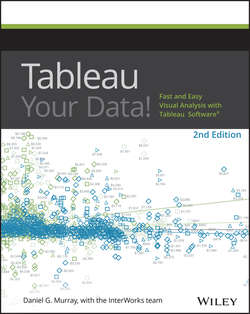Читать книгу Tableau Your Data! - Murray Daniel G. - Страница 6
На сайте Литреса книга снята с продажи.
Introduction: Overview of the Book and Technology
ОглавлениеThis book aims to provide an introduction to Tableau in the context of the needs of enterprises – large and small. With every Tableau deployment, there are several user constituencies – report designers who are responsible for performing analysis and creating reports, information technology team members who are responsible for managing Tableau Server and maintaining good data governance, and the information consumers who use the output and may want to do their own report creation.
This book's goal is to provide each group with a basic introduction to Tableau's Desktop and Server environments while also providing best practice recommendations that encompass novice, intermediate, and advanced use of the software.
How This Book Is Organized
There are four distinct sections. Part I (Chapters 1–10) covers the basics of Tableau Desktop and then progresses to more advanced topics including best practices for building dashboards to ensure they are understandable to end users, load quickly, and are responsive to query requests made by your audience. A lot of new and updated content had to be created in Chapters 1–5 because of interface enhancements and added capability in the tool. Chapter 6 includes expanded content related to data discovery and editing content on Tableau Server. Chapter 7 includes new tips and tricks that relate to V9+. Chapter 8's detailed dashboard example has been edited to include an additional action to create a floating and disappearing chart. Tablet computers have become ubiquitous and Tableau has added more capability in its web/mobile platform, so this edition includes a new Chapter 9 on mobile design and consumption with additional content. Chapter 10 on Story Points is also a completely new chapter.
Part II (Chapters 11–13) focuses on Tableau Server, mostly from the perspective of a technology manager responsible for installing, securing, and maintaining the Tableau Server environment. Tableau Server Version 9 is one of the most significant upgrades to Tableau Server ever. Not only has the user interface been redesigned and improved, but the backend processes have been enhanced, and Tableau's API toolset has been expanded. Consequently, every chapter in Part II contains significant content updates and additions.
Part III (Chapter 14) includes a new case study that provides tips for ensuring successful Tableau deployments. Cigna Healthcare created an internal user group aimed at improving employee skills and building enthusiasm around their Tableau deployment.
Part IV (Appendixes A–G) provides additional details on Tableau Software's current product ecosystem, supported data connections, keyboard shortcuts for Windows and the Mac, and recommended hardware configurations, and also includes a detailed Tableau function reference that provides explanations for function syntax and code samples. Some of these sections were included in the chapter content in the first edition. Due to their dynamic nature of the material, it made sense to break them out into separate appendixes so that we could include the most up-to-date information as close to publication as possible.
It's a challenge writing a book on this product line. Tableau Software's research and development spending reached an all-time high last year, and Tableau’s management team remains committed to 12–15 month major release cycles. There isn't a lot of time to update a guide that is 600+ pages.
Who Should Read This Book?
This book is intended to introduce new users to the features that Tableau Desktop has to offer from the perspective of someone who needs to create new analysis or reporting. It is also intended for staff responsible for installing, deploying, and maintaining Tableau Server.
The chapters related to Tableau Server are more technical because the subject matter assumes that you have a grasp of server terminology and security.
You can read the book sequentially from start to finish. Or, you can skip around and read about a topic of particular interest. Each chapter builds on the previous material, but if you've already mastered the basics of connecting and using the Desktop, you can skip any chapter related to Tableau Desktop and focus on topics of interest. Care has been taken to cross-reference related topics. So if you are the type of reader who wants to skip to a particular topic, breadcrumbs have been dropped so you can efficiently find related topics.
Tools You Will Need
You can read the book without having Tableau Software installed on your computer, but you'll get a lot more from the material if you follow the examples yourself. Tableau provides free trials of the software. Alternatively, you can download Tableau Public for free, indefinitely – all of the book examples related to Tableau Desktop should work on Tableau Public.
What's on the Companion Website?
Tableau constantly updates the Desktop and Server products with multiple maintenance releases and at least one major product release every 12 to 15 months. The book's companion website includes articles related to the releases, sample files related to the book's examples, and also examples related to new capabilities added to the product as Tableau makes them available. The InterWorks team actively tests new Tableau products, so the companion website may also include demonstrations of new visualization types or techniques before they become available publicly.
Wiley also has a website dedicated to the book that you can find at www.wiley.com/go/tableauyourdata2e.
Summary
Tableau lowers the technical bar for accessing data from many different data sources. This book should allow you to advance your technical ability and save time deploying Tableau in your enterprise by enabling you to make better decisions earlier in your deployment.
